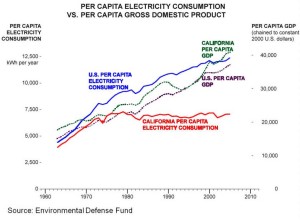California
California has a long tradition of climate change action and has taken meaningful steps to reduce greenhouse gas (GHG) emissions, in both legislation and attitude. They were early adopters of putting a price on carbon with cap and trade, and are continuing to refine that system.
California Legislation
Assembly Bill 32 – The Global Warming Solutions Act – serves as the cornerstone for progress. California has a broad portfolio of emission reduction strategies. Four key legs of implementation are:
- The Renewables Portfolio Standards Program. California has had an RPS since 2002 when the first goal was set requiring that renewables make up 20 percent of the state’s electricity mix by 2017. This was accelerated in 2006 to 20 percent by 2010 with the Global Warming Solutions Act. In 2011 the RPS was increased to 33 percent by 2020, and with SB 350, passed in 2015, the RPS requirement increased to 50 percent by 2030. California is essentially on track for 2020.
- The Advanced Clean Cars Program, established in 2012, set GHG standards for cars and light trucks for model years 2017-2025. The Zero Emission Vehicle (ZEV) program, projects about 230,000 vehicles in the ZEV fleet by 2025.
- Cap and Trade sets a declining cap on allowed GHG emissions. Beginning in 2013 the largest carbon emitters were required to meet the caps or buy credits; the cap was extended to transportation fuels in 2015.
- The Low Carbon Fuel Standard (LCFS), readopted in 2015, requires a 10% reduction in carbon emissions by 2020 from transportation fuels sold in CA.
A supporting action, passed in 2008, is the Sustainable Communities and Climate Protection Act (SB 375) . This legislation built on the regional GHG emission reduction targets for cars and light trucks, with required coordination of land use, transportation, and housing decisions to help achieve the target.
Senate Bill 350 – passed in 2015, codifying two of the “pillars” in Governor Brown’s Executive Order B-30-15; requiring the the Renewable Portfolio standard reach 50 percent by 2030, and to “achieve a cumulative doubling of statewide energy efficiency savings in electricity and natural gas final end uses of retail customers”, which in effect means a doubling of energy efficiency in the entire portfolio of California’s buildings by 2030.
Senate Bill 32: California Global Warming Solutions Act of 2016 advances the GHG emissions target to 40% below 1990 levels by 2030.
Assembly Bill 197, a companion bill to SB 32, provides transparency and additional accountability for the California Air Resources Board who is in charge of implementing the requirements of SB 32. AB 197 adds disadvantaged communities and those most affected by air pollution as a priority consideration. It also includes use of social cost of carbon in evaluating the cost-effectiveness of emission reduction measures to better account for the full array of costs and benefits associated with reducing greenhouse gas emissions.
Senate Bill 1383 requires the development and implementation of a Short-Lived Climate Pollutant Strategy for short-lived climate pollutants (SLCPs). Hydrofluorocarbons and methane must be reduced by 40% and black carbon by 50% below 2013 levels by 2030.
Economic and Emissions Effect
California made a push toward renewable energy, particularly solar, in the early 70s, and further encouraged reducing all energy, particularly electricity, use. That program worked to slow per capita use. The decrease in energy use has saved Californians billions of dollars.
The efforts to reduce per capita electricity use in California had no broad negative effect on the economy.
While California’s per capita electricity consumption has now held steady for three decades, per capita gross state product (GSP) has doubled and has outpaced the rest of the U.S.
Data from NASA and Environmental Defense Fund.
Click on figure to enlarge.
Since California announced a cap on carbon in 2006, according to the Environmental Defense Fund, more than $12 billion in clean energy venture capital has come into the state, a figure higher than all other states combined.
Cap and Trade
In 2011, Cap and Trade was established in California to set a declining cap on allowed GHG emissions. The cap-and-trade plan is a central part of AB 32. Under cap-and-trade, the largest carbon emitters, including refineries, power plants, industrial facilities, and transportation fuels, were required to meet the caps or buy credits.
The program is phased in. From 2012 through 2014, major electricity generators, industrial facilities and suppliers of carbon dioxide for industry were regulated. From 2015 through 2017, fuel suppliers and distributors, including suppliers of natural gas, transportation fuels and liquefied petroleum gas, are regulated.
Each year, the California Air Resources Board (CARB) determines the total cap on GHG emissions from all covered sources. That number is then divided into “allowances”. The cap, and corresponding allowances, is reduced each year sufficient to reach a 15% reduction of GHGs by 2020.
Cap and trade was hampered by litigation beginning in 2013. The case brought by the California Chamber of Congress claimed that cap and trade is a form of tax and so requires a 2/3 vote. AB 398 was passed and signed into law in 2017. It extended cap and trade to 2030 and passed with a 2/3 vote making the litigation moot.
Revenue Use
Government programs investing in ways to reduce greenhouse gases (mitigation) or to make the investments needed to adapt to the changes we are seeing and will see (adaptation) is the revenue use preferred in California. In this way we use the money to compound the benefit; we attack the problem of climate change using a price on carbon to encourage the market to work to reduce carbon emissions, and at the same time invest that money in changes needed to move toward the new economy.
2017 Climate Change Scoping Plan Update
The most recent update to the plan to reach the daunting goals set by the legislation is the 2017 Climate Change Scoping Plan Update, released January 20, 2017. The plan sets out a broad, comprehensive strategy. Particularly with reference to cap and trade the plan states:
“Post-2020 Cap-and-Trade Program
- Declining caps, continued linkage with Québec, and linkage to Ontario, Canada.
- CARB will look for opportunities to strengthen the program to support more air quality co-benefits, including specific program design elements. In Fall 2016, ARB staff described potential future amendments including reducing the offset usage limit, redesigning the allocation strategy to reduce free allocation to support increased technology and energy investment at covered entities and reducing allocation if the covered entity increases criteria or toxics emissions over some baseline.”
Last update, September 14, 2020
